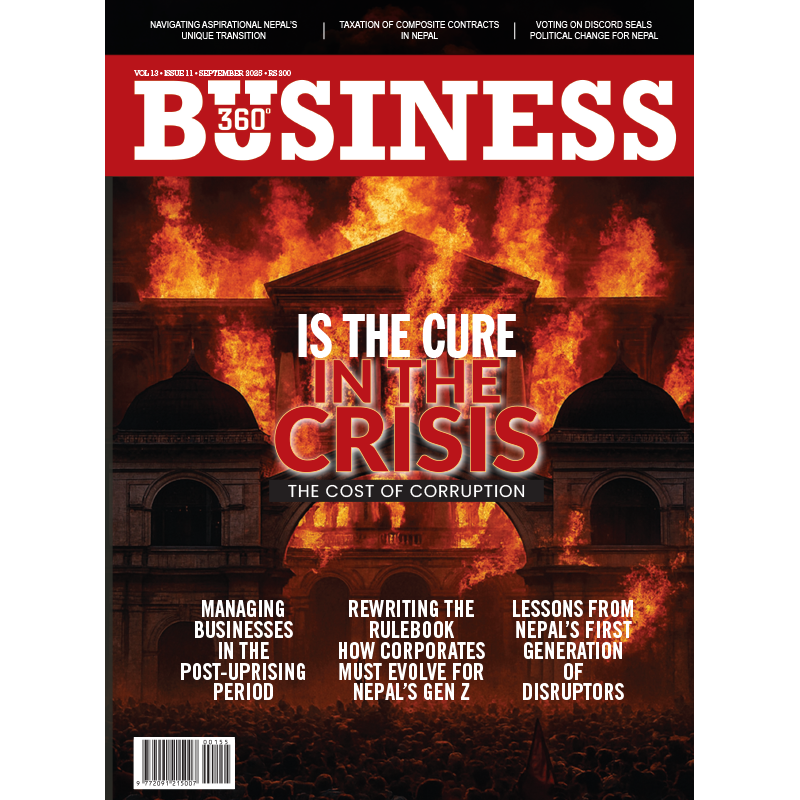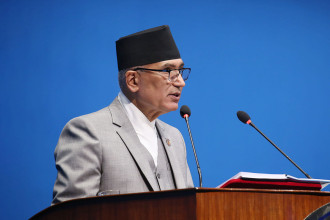Amidst the slowdown of economic activities in the country, there are projections of sluggish economic growth in the ongoing fiscal year 2023-24. However, the government has anticipated achieving 6% growth in this fiscal through the implementation of the policies and programmes incorporated in the fiscal budget. But multilateral development partners – Asian Development Bank and World Bank Group – have projected the GDP (gross domestic product) growth to remain at 4.3% and 3.9%, respectively. Further, the most conservative forecast comes from the International Monetary Fund (IMF) at 3.5%.
The Asian Development Bank, in its recently unveiled flagship publication, Asian Development Outlook (ADO), stated that external risks remain relatively well contained, and the target of maintaining foreign exchange reserves sufficient to sustain at least seven months of imports seems achievable. Amidst stable remittances and higher imports, the current account deficit is expected to widen to 1.8% of GDP as growth revives in this fiscal.
However, it has flagged that downside risks to the economic outlook in fiscal 2023-24 may arise from more contractionary economic policy by the authorities to stem price rises given the uncertainties centred around geopolitical tensions. This may dampen consumption and domestic production and adversely affect growth.
The government has been facing trouble in estimated revenue mobilisation and this will certainly hit the capital expenditure target. Low spending on infrastructure development and capital formation gives less room for leveraging resources for expanding economic activities. It is obvious that the economy has plunged into a recession as we have witnessed negative growth for three consecutive quarters since the last quarter of fiscal 2021-22 including the first two quarters of fiscal 2022-23. According to former Finance Minister Yubaraj Khatiwada, “There are mainly two reasons for this particular situation. The first is political instability which has compelled the head of the government to be confined in keeping the ruling alliance intact by any means and resultantly the government has not been able to take necessary initiatives to cope with the challenges of the economy. The second is due to the contractionary monetary policy of Nepal Rastra Bank.”
Economic growth over the years
| Fiscal Year | Growth |
| 2012/13 | 3.53% |
| 2013/14 | 6.01% |
| 2014/15 | 3.98% |
| 2015/16 | 0.43% |
| 2016/17 | 8.98% |
| 2017/18 | 7.62% |
| 2018/19 | 6.66% |
| 2019/20 | -2.37% |
| 2020/21 | 4.84% |
| 2021/22 | 5.61% |
| 2022/23 | 1.86% |
| 2023/24 | ? |
In the last 10 years, low growth of below 4% has been witnessed in a majority of the fiscal years, and it was even negative in one fiscal. The highest growth ever in fiscal 2016/17 of 8.98% was a base effect of the extremely low growth in 2015/16 caused by the undeclared blockade of India when the economy was already shattered by the earthquake. The country witnessed negative growth in fiscal 2019/20 after four decades due to the manifold impacts of the Covid 19 pandemic. The impact of the pandemic coupled with the Russia-Ukraine tensions triggered a slowdown in the global economy including Nepal.
Vicious cycle
Burgeoning trade deficit, low productivity and stagflation are considered structural challenges of the economy. These challenges require to be addressed with short-term, medium-term and long-term policy actions as boosting productivity, lowering trade deficit and creating employment are fundamental for the economy which has been gradually losing production base in manufacturing and agriculture. Production is highly inefficient and total factor productivity is zero, as per Swarnim Wagle, a lawmaker and former Vice Chairperson of the National Planning Commission.
Nepal is in a vicious cycle of import-based consumption for revenue collection. A large chunk of the revenue is being collected at the customs points through the import of goods. Customs are the source of 50% of the tax revenue, according to the Department of Customs (DoC). Contraction in imports along with soaring commodity prices including that of fuel in the global market have discouraged consumption in the domestic market. In the meantime, Nepal Rastra Bank has enforced stringent provisions – cash margin and increased risk weightage of import credit – which has further plunged imports and also consumption.
The central bank has annulled the 50% to 100% cash margin provision while opening letter of credit (L/C) for import, however import has squeezed in this fiscal too. According to DoC, imports and exports slumped by 5.06% and 7.79% respectively in the first two months of this fiscal.
Foreign trade
| Trade indicators | First two months of 2022-23 (Rs in bn) | First two months of 2023-24 (Rs in bn) | Change |
| Import | 273.59 | 259.75 | -5.06% |
| Export | 28.68 | 26.45 | -7.79% |
| Trade deficit | 244.92 | 233.30 | -4.74% |
(Source: Department of Customs)
Revenue mobilisation from consumption-based import and redistribution of revenue through public expenditure increasingly tempts the government to facilitate consumption-based imports that are mainly fuelled by remittances. “There would not have been any issue if the government channelised public spending in productive capacity enhancement of the economy, job creation, and addressing the infrastructure bottleneck,” said Dr Dilli Raj Khanal, Senior Economist, adding, “However, the quality of public spending is low. Improving the quality of public spending and developing efficiency of spending are critical to accelerating and sustaining economic development.”
Revenue mobilisation in the first quarter of this fiscal year is far lower than the target. According to the Financial Comptroller General Office (FCGO), around 14% of the annual target worth Rs 1,472.48 billion has been collected in the first quarter. The trend of revenue mobilisation shows the annual revenue collection target is highly unrealistic. In the last fiscal 2022-23, only Rs 1,031.69 billion or 70.73% of the annual revenue collection target worth Rs 1,458.61 billion was achieved. Despite revenue collection having unexpectedly plunged in the last fiscal, the government has set an ambitious revenue collection target in this fiscal year too, which is a herculean task to achieve considering the economic situation.
Higher lending rate discouraging private investment
Lending rates are still in the higher territory. According to Nepal Rastra Bank, commercial banks have still kept a double-digit base rate. The weighted average lending rate of commercial banks is around 12.24%. Though banks have enough loanable funds to expand private sector credit, there is slackness in loan demand due to the high lending rates. The Monetary Policy 2023-24 expected private sector credit to expand by 15% compared to the previous fiscal year. Anal Raj Bhattarai, Financial Sector Analyst, said that the target of 11.5% credit growth is a very ambitious one while taking into consideration the 3% credit growth in fiscal 2022-23. The central bank has recently amended the threshold of margin lending and real estate lending. However, such a piecemeal approach hardly addresses the deep-rooted problem of the economy. Amending its directives, NRB has raised the single obligator limit of margin loan to Rs 200 million from Rs 120 million. Further, the loan to value ratio against the collateral of land in Kathmandu valley has been increased to 50% from 40% earlier.
Way forward
There has been an improvement in external sector stability due to high remittance inflow, shrinking imports and disbursement of foreign loans and grants in foreign aid projects. The country has high foreign exchange reserves in the current situation. The country’s foreign currency reserves till mid-August stood at $11.85 billion which is sufficient to cover the import of goods and services for 10.3 months. Similarly, the country received remittances worth Rs 116.02 billion in a single month till mid-August with 25.8% growth in remittances inflow.
Meanwhile, the balance of payments surplus was at Rs 32.90 billion. The current account surplus hovered at Rs 12.99 billion in mid-July to mid-August of this fiscal year as compared to a deficit of Rs 15.13 billion in the corresponding period of the previous fiscal year. It is reported that banks have a cushion of Rs 500 billion loanable funds and is flush with liquidity due to lack of credit expansion.
Rajesh Kumar Agrawal, President of the Confederation of Nepalese Industries, opined that the slackness and insular sentiment among the entrepreneurial mass should be quashed without delay and confidence must be boosted with positive intervention amidst the widespread pessimism for economic comeback. Most importantly, the precious resources that will be mobilised by the government as public spending should ensure efficiency and quality while being mobilised in productive capacity enhancement, infrastructure development of synergic impact and investment in human development. On the other hand, government spending should leverage the private sector investment to propel growth, assets and job creation as well as to provide stability in the economy to cope with the aforesaid structural challenges – burgeoning trade deficit, low productivity and stagflation.


-1758006240.jpg)
-1752225714.jpg)

